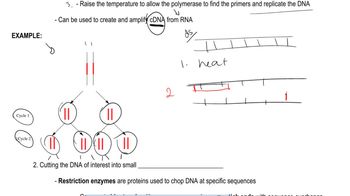How might you use CRISPR–Cas9 to create a large deletion?
Table of contents
- 1. Introduction to Genetics51m
- 2. Mendel's Laws of Inheritance3h 37m
- 3. Extensions to Mendelian Inheritance2h 41m
- 4. Genetic Mapping and Linkage2h 28m
- 5. Genetics of Bacteria and Viruses1h 21m
- 6. Chromosomal Variation1h 48m
- 7. DNA and Chromosome Structure56m
- 8. DNA Replication1h 10m
- 9. Mitosis and Meiosis1h 34m
- 10. Transcription1h 0m
- 11. Translation58m
- 12. Gene Regulation in Prokaryotes1h 19m
- 13. Gene Regulation in Eukaryotes44m
- 14. Genetic Control of Development44m
- 15. Genomes and Genomics1h 50m
- 16. Transposable Elements47m
- 17. Mutation, Repair, and Recombination1h 6m
- 18. Molecular Genetic Tools19m
- 19. Cancer Genetics29m
- 20. Quantitative Genetics1h 26m
- 21. Population Genetics50m
- 22. Evolutionary Genetics29m
15. Genomes and Genomics
Genomics and Human Medicine
Problem 4
Textbook Question
Using the data in Table B, calculate the average number of kilobase (kb) pairs per centimorgan in the six multicellular eukaryotic organisms. How would this information influence strategies to clone genes known only by a mutant phenotype in these organisms?

 Verified step by step guidance
Verified step by step guidance1
Identify the data provided in Table B for the six multicellular eukaryotic organisms, specifically the total genome size in kilobases (kb) and the total genetic map length in centimorgans (cM).
For each organism, calculate the average number of kilobase pairs per centimorgan by dividing the total genome size (in kb) by the total genetic map length (in cM). Use the formula: .
Once the calculations are complete for all six organisms, compute the overall average by summing the individual averages and dividing by the number of organisms (6 in this case).
Interpret the calculated average kb/cM values to understand the physical distance represented by 1 cM in these organisms. This provides insight into the resolution of genetic mapping in each organism.
Discuss how the kb/cM values influence gene cloning strategies. For example, organisms with a higher kb/cM ratio may require more extensive physical mapping or sequencing to identify genes associated with mutant phenotypes, while organisms with a lower kb/cM ratio may allow for more precise localization of genes.
 Verified video answer for a similar problem:
Verified video answer for a similar problem:This video solution was recommended by our tutors as helpful for the problem above
Video duration:
2mPlay a video:
Was this helpful?
Key Concepts
Here are the essential concepts you must grasp in order to answer the question correctly.
Kilobase (kb) and Centimorgan (cM)
Kilobase (kb) is a unit of measurement in genetics that represents 1,000 base pairs of DNA. A centimorgan (cM) is a unit of genetic linkage that reflects the frequency of recombination between two loci on a chromosome, with 1 cM corresponding to a 1% chance of recombination occurring. Understanding the relationship between kb and cM is crucial for mapping genes and estimating genetic distances.
Recommended video:
Guided course

Genetic Cloning
Gene Cloning
Gene cloning is a molecular biology technique used to create copies of a specific gene or DNA segment. This process often involves isolating the gene of interest, inserting it into a vector, and introducing it into a host organism for replication. Knowledge of genetic distances, such as kb per cM, can inform strategies for identifying and isolating genes associated with specific phenotypes, especially in organisms where the gene is not directly observable.
Recommended video:
Guided course

Positional Cloning
Mutant Phenotype
A mutant phenotype refers to a visible or measurable change in an organism's traits resulting from a mutation in its DNA. These phenotypes can provide clues about the underlying genetic changes and are often used in research to identify and study specific genes. Understanding the relationship between mutant phenotypes and their corresponding genetic loci is essential for developing effective gene cloning strategies in multicellular eukaryotes.
Recommended video:
Guided course

Mutations and Phenotypes

 6:51m
6:51mWatch next
Master Human Genome Composition with a bite sized video explanation from Kylia
Start learningRelated Videos
Related Practice
Textbook Question
570
views
